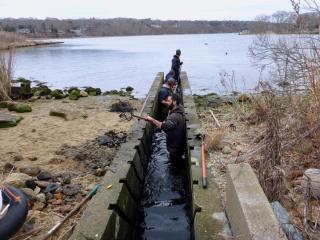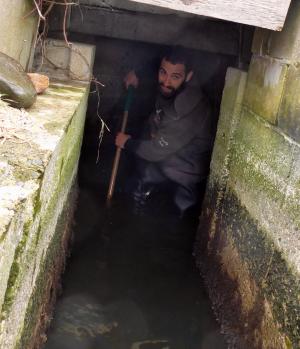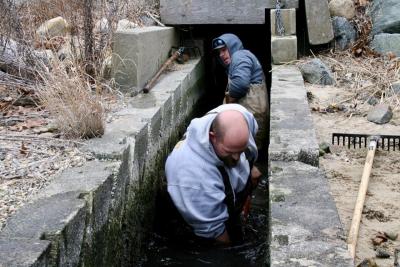March 29: Oak Bluffs and Tisbury team up to clean up herring run

What's going on in the Shellfish Department
On Friday, March 29 a team that included members of the Tisbury and Oak Bluffs Shellfish Departments, the Oak Bluffs Water Company and several volunteers cleaned out the Richard F. Madeiras herring run at the head of Lagoon Pond.
The work was hard, wet and cold. Standing in waders the team removed large boulders, trash and silt from the sluice way herring use to return to their natal pond. Once the run was clean, new boards were inserted into the sluiceway to break up the current, which allows the herring to swim upstream.
The herring run, jointly administered by the towns of Oak Bluffs and Tisbury, was permitted and built through the efforts of town officials and community volunteers. After years of work, the completed run was stocked with herring which spawned and produced offspring that now return year after year in the early spring.
Herring begin running in late March.

Ben Madeiras clearing out the run
Spring rain swells the streams and rivers that flow into the sea and provide a watery path for river herring, also called alewives, intent on returning to the fresh water pools of their birth.
The natural cycle of returning alewives was witnessed and welcomed by the Wampanoag Indians who first inhabited the Island and early European colonists who exploited the many productive runs around the Island where fresh water mixed with the salt.
The arrival of the silvery fish is still anticipated by Islanders. But the diminishing numbers of returning herring, even by modern standards, prompted state fisheries managers in 2005 to prohibit the possession or sale of herring, effectively closing all herring runs in the state.
Two species of fish in coastal Massachusetts are collectively referred to as river herring. They are the alewife, which spawns from late March to mid-May when water temperature reaches about 51 degrees, and the blueback herring, which spawns from late April to June when the water temperature is about 57 degrees, according to state biologists.
Herring do not return to spawn for three to four years after leaving their birth waters for the open ocean. Taking too many herring before they have had a chance to spawn can have a precipitous affect.
The exact cause of the herring decline remains a mystery. Rainfall levels, water quality, the taking of river herring by large offshore pair trawlers targeting sea herring, and a resurgence of striped bass have all been mentioned as possible causes. Whatever the cause for the decline in fish numbers, fisheries officials across the region have decided it is best to be conservative.
No one is allowed to take herring from the Lagoon Pond run.

Brian Patrick Hall and Lucas Landers clearing out the run
- Log in to post comments

